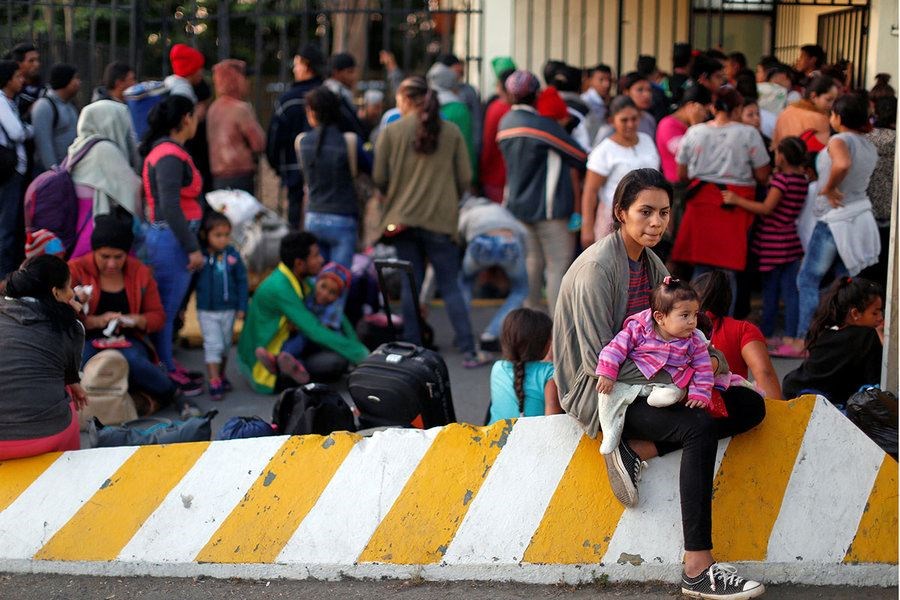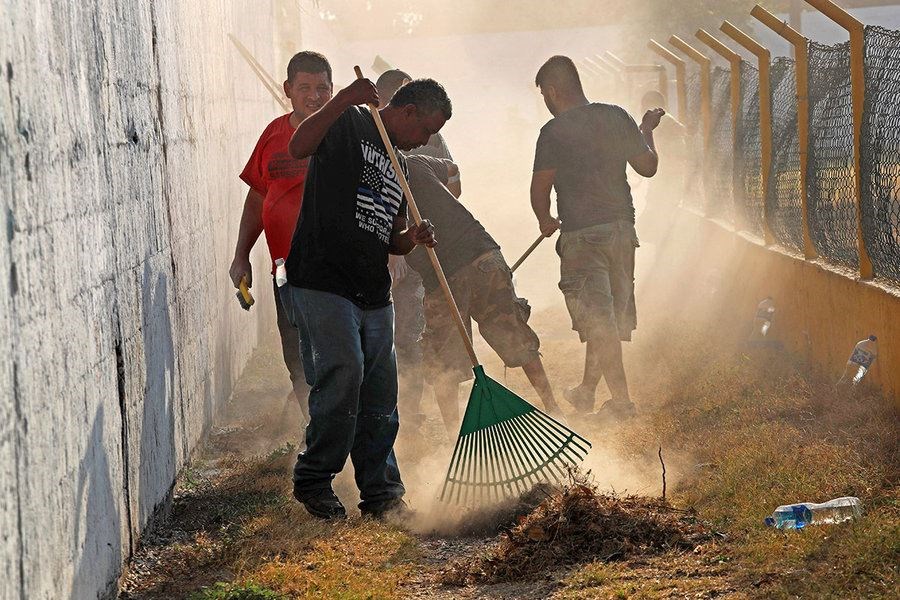Reprinted with permission from The Christian Science Monitor
With migration, it can seem as if the story never changes: long lines of people, fleeing things they fear, trying to enter countries that don’t want them. But in Mexico, lessons from the past year are shaping a new response.
JANUARY 25, 2019 - TECÚN UMÁN, GUATEMALA - Marlin Yanina Alcántar Lobo is sprawled on a foam mattress in a municipal hall on the Guatemala-Mexico border after a grueling five-day walk.
 A woman walking with other migrants from Honduras to the United States holds her daughter as they wait at the Mexico border-brige in Tecun Uman, Guatemala, Jan. 19. This migrant caravan faces a very different reception from Mexican officials than previous caravans.Jose Cabezas/ReutersTraveling with her two young children, Ms. Alcántar is getting the rest she can while waiting for volunteer medics to tend to her 9-year-old daughter’s scraped leg. She’s poised to walk thousands of miles farther north with a group of more than 2,000 migrants and asylum-seekers that trickled out of San Pedro Sula, Honduras, starting Jan. 15.
A woman walking with other migrants from Honduras to the United States holds her daughter as they wait at the Mexico border-brige in Tecun Uman, Guatemala, Jan. 19. This migrant caravan faces a very different reception from Mexican officials than previous caravans.Jose Cabezas/ReutersTraveling with her two young children, Ms. Alcántar is getting the rest she can while waiting for volunteer medics to tend to her 9-year-old daughter’s scraped leg. She’s poised to walk thousands of miles farther north with a group of more than 2,000 migrants and asylum-seekers that trickled out of San Pedro Sula, Honduras, starting Jan. 15.
They left with the mantra “En Honduras nos matan” (In Honduras we’re killed), referring to the political instability, organized crime, and violence that touches nearly every corner of the country. The so-called caravan has been joined by hundreds from El Salvador and Guatemala, traveling together, like groups before them, in hopes of maintaining safety in numbers.
This past October, when one of the largest caravans to date was in Alcántar’s position, preparing to cross into Mexico, the situation was starkly different. Under pressure from the US government, then-President Enrique Peña Nieto sent 200 police in riot gear to the border, and security forces blocked off the pedestrian bridge connecting Mexico and Guatemala, creating an anxious crowd of migrants that seemed poised to end in a stampede. Helicopters flew above the Suchiate River, whipping up the water as people tried to cross.
Today, the United States continues to debate a southern border wall and put pressure on its southern neighbors to halt migration north. A new US policy goes into effect Friday that will block non-Mexican asylum-seekers from entering the US, requiring them to wait weeks or months in Mexican border cities before pleading their cases in the US. Mexico, meanwhile, has made a dramatic change in its approach to caravans arriving at the border. Government workers hand out educational materials and give talks about the options that await migrants in Mexico, including year-long humanitarian visas to allow them to work, or applying for asylum.
Past policies, like Mr. Peña Nieto’s Plan Frontera Sur, aimed to formalize southern-border migration, but the focus on detention meant many migrants chose to enter clandestinely rather than risk an encounter with a Mexican border agent. The seemingly basic steps this year, under new President Andrés Manuel López Obrador, have big implications, allowing migrants to enter and travel (or remain) in Mexico without being pushed into the shadows because of their lack of papers. In theory, this could mean fewer abuses by officials, gangs, or traffickers.
 Central American migrants who have received humanitarian visas clean a public sports stadium, which is being prepared as a shelter migrants crossing into Ciudad Hidalgo, Mexico, on the border with Guatemala, on Jan. 21, 2019. Thousands more are waiting for humanitarian visas, which give permission to be in Mexico for one year and work legally.Marco Ugarte/AP“You can tell that there’s really been a change in terms of Mexico’s immigration policy, which is now focused on human rights,” says Pierre-Marc René, a spokesperson for the United Nations Refugee Agency in Mexico.
Central American migrants who have received humanitarian visas clean a public sports stadium, which is being prepared as a shelter migrants crossing into Ciudad Hidalgo, Mexico, on the border with Guatemala, on Jan. 21, 2019. Thousands more are waiting for humanitarian visas, which give permission to be in Mexico for one year and work legally.Marco Ugarte/AP“You can tell that there’s really been a change in terms of Mexico’s immigration policy, which is now focused on human rights,” says Pierre-Marc René, a spokesperson for the United Nations Refugee Agency in Mexico.
Many are applauding the government’s new approach as more humanitarian. But plenty of questions remain, including consequences for people who stay in Mexico, if it will provide further protections to migrants, what will happen to visa-holders when their permits expire, and what it means for local employment.
“[T]his caravan is going to be very telling about the Mexican government’s reaction” to the large groups of migrants that are increasingly moving through the region, says Néstor Rodríguez, an immigration expert at the University of Texas at Austin.
“This is really important because Mexico is really in the middle, between Central America and the US, so staying in Mexico creates a second option for those who are really in danger and can’t get into the US,” he says.
So far this year, 10,341 Central Americans have requested a one-year humanitarian visa that can be obtained in three to five days, according to the Mexican government. Humanitarian visas are renewable and allow immigrants free movement throughout the country and formal employment. Fewer than 50 have applied for asylum, a process that takes up to three months. Asylum status is a first step toward obtaining permanent residency.
Applicants must remain in Tecún Umán, on the Guatemalan side of the border, while Mexican authorities process visa requests. Those who enter Mexico through illegal border crossings rather than official immigration checkpoints can still apply for humanitarian visas at a later point, but risk deportation.
“This is a complete change in policy [and is] in contrast with other countries also facing immigration challenges,” says José María Ramos, an immigration expert at the Colegio de la Frontera Norte (Colef), based outside Tijuana.
In the US, foreigners can apply for asylum at ports of entry or once they’re already inside the country. Because of recent trends of “metering,” or limiting how many people can ask for asylum at formal entry points into the country, many migrants choose to risk crossing on their own, intentionally handing themselves over to officials once on the US side of the border. That may change in coming weeks, as the US’s so-called remain-in-Mexico policy goes into effect.
A growing number of Central Americans view Mexico as a final destination. The United Nations High Commissioner for Refugees (UNHCR) estimates that 40 percent of those traveling with the previous three caravans requested asylum in Mexico.
“If we can stay in Mexico, at least we’ll have a job and a safer place to live,” says Honduran migrant Heidy Marleny Castro, who is traveling with two of her children, ages 8 and 13. They had tried to enter Mexico this past fall but returned to Honduras after waiting for three days at the bridge.
Not everyone in Mexico is on board with the work visas and the possibility of more employment-seeking migrants in the country. On Jan. 22, the Chiapas chapter of Mexico’s employers’ association (COPARMEX) issued a statement expressing its “outright rejection” of the caravans arriving on the southern border, and its concerns around the new immigration policies.
“Receiving such a huge number of undocumented aliens can lead to an increase in insecurity, violence, illegality, and even disease,” the statement said. Before assisting immigrants, COPARMEX said, the López Obrador administration should assist displaced indigenous people in Chiapas and should offer jobs generated by new government construction projects to locals rather than Central American migrants.
But many in the caravan, such as Alcántar, say their intentions are still set on reaching the US. Often it comes down to family already there or a skepticism around Mexico’s about-face on migration policy.
Almost 4,000 people have died or gone missing while migrating through Mexico over the past four years alone, the UNHCR said in an interview. Although the humanitarian visas could help make migrants less vulnerable to trafficking or gang recruitment, the results remain to be seen. This past fall, some state governments in Mexico provided transportation and other protections to the caravan as it crossed the country, speeding the migrants’ passage through their territory. In others, though, migrants continued to walk through sometimes dangerous territory or extreme conditions. It is unclear whether the new federal policies will change state approaches.
In 2018, President Trump threatened to cut aid to Honduras, Guatemala, and El Salvador if they didn’t halt their citizens from fleeing north. If the leftist Mr. López Obrador’s government actively encourages states to shuttle migrants across the country, even if under the banner of safety and security, Mr. Ramos from Colef says Washington could accuse Mexico of encouraging illegal immigration.
With many members of the previous caravan still stuck in Tijuana, vying to lodge asylum requests or cross the border into the US, another key challenge for the Mexican government will be preventing overcrowding and unrest along the northern border in coming weeks.
“Most of them won’t qualify for asylum in the US and will wind up stuck in Tijuana,” says Ramos, citing the high bar for arguing asylum cases. “While these immigrants await a resolution from US authorities, the challenge for the Mexican administration will be to assign the necessary budget to offer them health care, education, and employment” – a tall order, he says.
Page created on 1/26/2019 9:22:34 AM
Last edited 1/26/2019 9:56:50 AM
